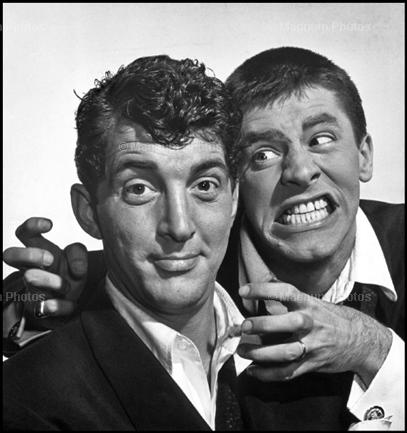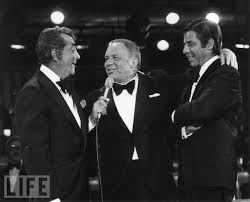
Dean Martin and Jerry Lewis became famous as a performing duo and
starred in a series of popular comedy films in the 1950s. Their output was
extraordinarily prolific with four films made in 1953 alone and sixteen
altogether between 1949 and 1956. Lewis was the comic with his slapstick antics,
rubber face, supple body and wide range of voices. Martin was the perfect foil
as the straight man and his singing talent added an extra dimension. At their
peak the pair were also performing on radio and television and had been a
popular stage act before moving into films.
They split acrimoniously in 1956. Both continued as solo artists – Lewis
in film and later as a singer; Martin as a singer, straight actor and host of a
popular television variety show.
The material below has been drawn mainly from Dean Martin’s biography
“Memories Are Made of This”, by Martin’s daughter Deana and co-written by Wendy
Holden. The book is named after one of Martin’s most enduring hit songs. Any
direct quotes from the book are acknowledged as such.

MARTIN AND LEWIS – A DREAM COMBINATION, CUT SHORT
They were an odd couple. A smooth crooner and a rubber-faced clown.
Dean Martin was ten years older than Jerry Lewis and had first come to the
public’s attention as early as 1939 when at 22 he became lead singer with the
Ernie McKay band playing in Columbus, Ohio. His home town was Steubenville,
Ohio. He moved on (and up) to Sammy Watkins band in Cleveland. Over this period
his name changed from Dino Crocetti (his birth name) to Dino Martini and finally
to Dean Martin.
In June, 1944 he began recording for radio.
His major break came in 1946 when he secured a recording contract with Diamond
Records and was engaged by the Riobamba club in Manhattan. He moved to New York
and was soon doing the general night club circuit. He faced stiff competition
from Bing Crosby, Frank Sinatra and Perry Como who were moving in the same
circles and considerably more popular. 19 year old Jerry Lewis (birth name
Joseph Levich) claimed he first met Martin in the street in 1945. He was working
the same circuit with a comedy act built around lip-synching opera arias while
changing costumes and making funny faces. Martin and Lewis often saw each
other’s act from the audience and both were impressed. Sometimes they were
performing in separate acts on the same bill. They built a friendship and
interplay began between them, such as Jerry dressing as a waiter and clumsily
moving through the audience, dropping trays while Dean was singing on stage.
Ad-lib dialogue would take place between them. There would be similar interplay
when Jerry was on stage. This forerunner of the double act took place at the
Havana-Madrid nightclub, Manhattan.
Jerry developed the partnership further by advising the manager of the 500 Club,
where he was performing, to take on Dean Martin as a singer to fill a vacancy.
He didn’t tell Dean that what was really sought was a comedy team. The
partnership was formed and developed round the routines they had already
perfected in the earlier club encounters.
In January, 1947 they set themselves up as a permanent pairing and their first
engagement as “Martin and Lewis” was at Leow’s State theatre, New York. They
enjoyed instant success and their famous ten year partnership began. They
starred in their own NBC radio show and quickly moved into television, sharing
the hosting of the Colgate Comedy Hour and guesting on other shows.
Around the middle of 1948 the stage act moved to the west coast after a spell in
Chicago. They were regular performers at Slapsy Maxie’s Café in Wiltshire
Boulevard, Los Angeles. The audience included such Hollywood luminaries as
Humphrey Bogart, Tony Curtis, Janet Leigh, Fred Astaire, Clark Gable, Joan
Crawford, Jane Wyman, James Cagney and Gary Cooper.
In 1950 the act moved again, this time to Las Vegas. By now they had made their
first film together and quickly became world famous. They went on to make
fifteen more films as well as continuing in stage, radio and television comedy.
They controlled most business aspects of their activities and became enormously
wealthy.
It seems things started to go wrong in about 1954. Jerry Lewis was the more
influential partner regarding film input, contributing to the scripts for the
later movies. His knowledge of film was broader and he would later begin
directing. Dean Martin was the better known partner outside the comedy act,
having recorded 26 songs in 1950 alone and continued his prolific recording
career throughout the period of the comedy partnership (and well beyond, not to
mention his serious film acting and the Dean Martin Show which ran on NBC
television for 9 years from 1965). Lewis’s stronger influence on the film
content and Martin’s wider fame led to strife, jealousy and bitterness. Their 12th
film together, Three Ring Circus,
had Dean Martin as a character he didn’t
like; he was given just one solo song (which he had to perform in a cage full of
animals), and from this point Jerry appeared to push his partner to the
periphery and bring his own solo comedy to the fore.
From here on they rarely spoke to each other. Their new agent, Herman Citron,
tried to patch things up for their continuing club dates and three more movies (You’re
Never Too Young, Artists and Models,
and Pardners). Critics have noted
that the tension between them is observable in those movies. Things continued to
degenerate. Working on what turned out to be their last movie together (Hollywood
or Bust), Dean’s patience with Jerry’s ego and need to control everything
was running out. The director, Frank Tashlin, was also losing patience and at
one stage he ordered Jerry off the set.
According to daughter Deana Martin, who recounts the following exchange in her
book, the final straw was the script for what would have been their 17th
movie, The Delicate Delinquent. It
called for Dean to dress in a policeman’s uniform. “But I hate uniforms. Why
can’t I play a detective?” asked Dean. “Because the script calls for a cop,”
answered Jerry. “You wrote the damn script, change it. I don’t want to play a
cop.” “Then we’ll have to get someone else.” “Start
looking, boy,” replied Dean before turning and walking away.
The movie was made, without Dean Martin.
The news of the split broke early in 1956. Bud Abbott and Lou Costello (their
main comedy-duo rivals at the time) unsuccessfully urged them to make up. But
they themselves broke up before Martin and Lewis had even had a chance to reply
to them.
A few club contracts were fulfilled before the final parting, which was “aided”
by a Jerry Lewis magazine article criticising Dean and claiming that all he ever
wanted to do was play golf and do the minimum amount of work. Dean Martin then
publicly announced “I’ve severed all connections. As far as I’m concerned, Jerry
Lewis doesn’t exist anymore in my life.”
Lewis recounts a somewhat different version of the break-up, stating there was
general disagreement over the direction the pair wanted to go. He also claimed
that, through no fault of his own, the publicity and critical acclaim given to
the films was biased in favour of him and sometimes neglected Dean Martin’s
contribution altogether. He said that, just before the split, a film poster had
blanked out Dean Martin’s image and didn’t even mention his name.
Twenty years passed before they made up.
With his singing, acting and top-rating television show Dean Martin enjoyed the
higher profile of the two after the split. Jerry Lewis had a longer but less
successful solo career. Nonetheless he made some very funny films (as writer,
producer, director and star) that did well at the box office –
The Bellboy,
The Ladies Man,
Cinderfella and
The Nutty Professor among them. His
film career continued into the 21st century. He also made multiple
records as a singer, a talent he only realised fully for himself after the
break-up. But an injury in 1965 left him in permanent pain and he turned to
social work. His annual Telethon for muscular dystrophy was a major project (it
was actually started in 1952 by both him and Dean Martin). When Jerry Lewis was
MC for the Telethon in September, 1976 Frank Sinatra (presumably as a guest)
told him that he had “a friend waiting off-stage who loves what you do and who
just wanted to come out and say hello.” Dean Martin walked out. A warm embrace
and 20 years of mutual dislike seemed to dissolve away in an instant.

They remained in touch and there were two more significant moments. Jerry Lewis
quietly attended the funeral of one of Dean’s adult children in 1987, and on the
occasion of Dean’s 72nd birthday (June, 1989) it was Jerry Lewis who
appeared out of nowhere to push a huge birthday cake onto centre stage. “Why did
we ever split up?” was a question they both pondered.
When Dean Martin died on Christmas Day, 1995, aged 78, the three main speakers
at his private funeral were Shirley MacLaine, Greg Garrison (the producer of the
Dean Martin Show), and … Jerry Lewis.
While the friendship was restored from 1976, they never performed together
again.
Jerry Lewis died in Las Vegas in 2017 aged 91.
FILMOGRAPHY
1949 My Friend Irma
1950 My Friend Irma Goes
West
1950
At War with the Army
1951 That’s My Boy
1951 Sailor, Beware
1952 Jumping Jacks
1953 The Stooge
1953 Scared Stiff
1953 The Caddy
1953 Money From Home
1954 Living It Up
1954 Three Ring Circus
1955 You’re Never Too
Young
1955 Artists and Models
1956 Pardners
1956 Hollywood or Bust
They had only small parts in the first film (My Friend Irma), but thereafter all
the films were entirely a vehicle for their talent.